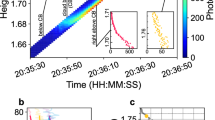Abstract
Although it has long been recognized that the effects of photon multiple scattering generally need to be accounted for in the analysis of lidar cloud returns, this is a difficult problem and current approaches are still rudimentary. The multiple scattering process is controlled by the size of the lidar beamwidth and the distance to the cloud, which jointly determine the lidar footprint, but cloud microphysical content (i.e., particle size, concentration, and shape) exerts a strong influence on the range distribution and depolarization of the returned energy. Since clouds are inherently inhomogeneous with height, it is our premise that vertically homogeneous cloud simulations based on idealized particle size distributions lead to misleading results. We offer a more realistic approach based on the contents of growing water droplet clouds predicted by a sophisticated adiabatic cloud model, which are offered for use as new standard vertically-inhomogeneous cloud models. Lidar returned signal and depolarization profiles derived from our analytical double-scattering method are given for inter-comparison purposes.
Similar content being viewed by others
References
R.M. Schotland, K. Sassen and R.J. Stone: J. Appl. Meteorol. 10 (1992) 2914.
S.R. Pal and A.I. Carswell: Appl. Opt. 12 (1973) 1530.
K. Sassen: Bull. Am. Meteorol. Soc. 72 (1991) 1848.
S.T. Shipley, E.W. Eloranta and J.A. Weinman: J. Appl. Aerosol Sci. 3 (1972) 455.
A.I. Carswell and S.R. Pal: Appl. Opt. 19 (1980) 4123.
S.R. Pal and A.I. Carswell: Appl. Opt. 24 (1985) 3464.
K. Sassen, H. Zhao and G.C. Dodd: Appl. Opt. 31 (1992) 2914.
K. Sassen and K.N. Liou: J. Atmos. Sci. 36 (1979) 852.
K. Sassen: J. Appl. Meteorol. 15 (1976) 292.
K. Sassen and H. Zhao: Proc. MUSCLE 4 (1991) p. 22.
L. Liao and K. Sassen: Atmos. Res. 34 (1994) 231.
K. Sassen and G.C. Dodd: J. Atmos. Sci. 45 (1988) 1357.
G. Hanel: Aerosol Sci. 3 (1972) 455.
K. Sassen and R.L. Petrilla: Appl. Opt. 25 (1986) 1450.
U. Wandinger: Ph. D. Dissertation, University of Hamburg (1994) p. 125.
K. Sassen and H. Zhao: J. Appl. Meteorol. 32 (1993) 1548.
D. Deirmendjian: Electromagnetic Scattering on Spherical Polydispersions (American Elsevier, New York, 1969) Chap. 4.
L. Bissonnette: Defence Research Establishment Valcartier, Electro-Optics Division, P.O. Box 8800, Courcelette, P.Q., GOA 1RO Canada (Fax: 418-844-4511, Email: lbisson@sv0.drev.dnd.ca).
Author information
Authors and Affiliations
Additional information
Presented at the 7th International Workshop on Multiple Scattering Lidar/Light Experiments (MUSCLE7), July 21–23 1994, Chiba, Japan.
Rights and permissions
About this article
Cite this article
Sassen, K., Zhao, H. Lidar Multiple Scattering in Water Droplet Clouds: Toward an Improved Treatment. OPT REV 2, 394–400 (1995). https://doi.org/10.1007/s10043-995-0394-2
Received:
Accepted:
Issue Date:
DOI: https://doi.org/10.1007/s10043-995-0394-2




